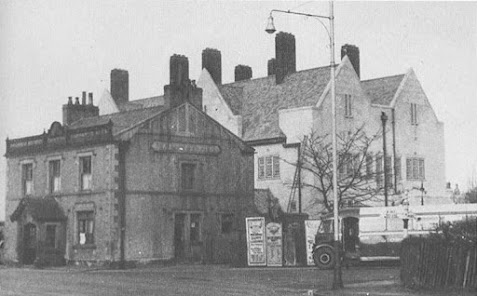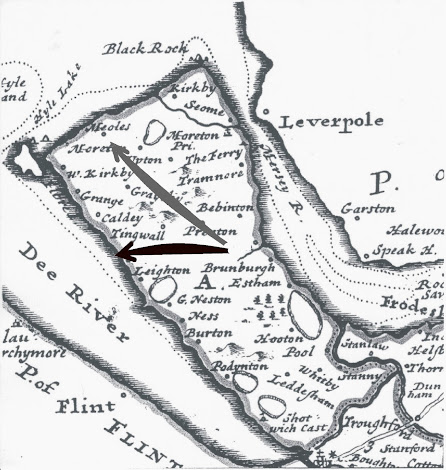The boat beneath the car park
In 2007 a planning application was made to construct a patio extension at the Railway Inn, Meols. The assessment that routinely followed by the County Archaeology Office revealed a document reporting a vessel of unknown antiquity that had been buried underneath. Potentially an archaeologist’s dream: a major find under a pub!
In 1938, when
the Railway Inn was being knocked down and rebuilt further from the road, the
site of the old pub being made into a car park, workmen had revealed part of a
clinker vessel from under the waterlogged blue clay 2-3 metres below the
original pub. A clinker has overlapping planks, a style which originated
from Scandinavia over 2000 years ago – mastered by the Angles and Vikings and characteristic of all their
shipping – and a style of boatbuilding so successful it has subsequently been
used through the ages and is still used today. The foreman on duty ordered the
workmen to put all the clay back, in case the work was held up by
archaeologists, costing time and money. This was duly done and the vessel was
largely forgotten about. A year later, the world was at war and the country had
more urgent priorities.
John McRae, the builder who discovered the boat in 1938, told the story to his family. Before his death in 1991, his son (also called John McRae) asked him to describe what he had seen, which he turned into a sketch. He sent the details to archaeologists at Liverpool Museums, who put them on record. The appearance of the sketch in 2007 sparked speculation as to the nature and date of the vessel. The report was brought to the attention of Tim Baldock, a local police officer and amateur history sleuth, who contacted me. Two questions arose – was this vessel still underneath, and what was it? This led to the hypothesis: could it have derived from the Viking Age settlers or their descendants? Or perhaps something else?
This hypothesis was recently considered by BBC’s Our Coast (https://www.nottingham.ac.uk/~sczsteve/BBC_OurCoast_BoatClip.mp4?fbclid=IwAR0XQAFqKSfAeSj-utrlQQHhkM8vi88uOXZ_vGAPR2dvPpKAyyiijOIOEIY) email me at steve.harding@nottingham.ac.uk if you have difficulty viewing this).
Geophysics
expert, Malcolm Weale of Geofizz Ltd, was commissioned to investigate, using an
integrated Magnetometer and GPR device. With the enthusiastic support of the
Railway Inn and consent from Greene King, who own the pub, litter bins, plant
pots and tables were all moved out of the way and the area in front of the
entrance was systematically scanned and analysed. A computer then converted the
signals into a profile of what is underneath the surface. The results appear to
show the outline of one end of a boat-shaped anomaly, which broadly matched the
position and dimensions given in John McRae’s sketch. Unfortunately, it was not
possible to extend the scanning because of a street lamp and other non-movable
objects that were in the way. And that is where investigations stopped in 2007.
The shape
and depth of the find prompted a number of news reports and headlines referring
to a Viking vessel. However, both the character and date of the find remain
unproven until further study is undertaken to resolve the mystery of the boat.
Nevertheless, the position and depth of the potential vessel raise the
possibility that it is of considerable antiquity. The location is approximately
1km away from the present coastline and even further from the medieval
coastline, which has been affected by erosion.
A much more
recent GPR survey conducted by James Slater of PM Surveys appear to support
these observations.
It is possible that the boat may have been washed in by an ancient flood and/or sank in a local marsh – the area is full of Old Norse field and track names associated with marsh and wetland. For much of the ninth and tenth centuries the Vikings controlled the Irish Sea and Meols (Melar ON, “sand hills”) was one if its main seaports with a natural harbour formed by a large sandbank known as “Hyle bank”. We also know that Wirral was an area of intense Scandinavian settlement with its own Thing parliament. Settlement has been confirmed by a detailed genetic study of Wirral and neighbouring West Lancashire showing high levels of Scandinavian genes in the DNA admixture of men from old families (possessing surnames present in the area prior to 1600). Knut Paasche, a Nordic ship expert from the University of Oslo, has scrutinised the 1938 sketch and report and has noted a similarity with a 30ft long clinker boat of the “Faering” type, a six-oared boat which could carry 12 people, which was discovered with the famous Gokstad burial vessel.
Excavation
was – and still is – not an option because of the enormous costs of
preservation and display. Sadly, researchers can’t just dig up an interesting
wooden find without a full preservation strategy in place: underground in the
oxygen-free (anaerobic) blue clay – microbial degradation is minimal and the
wood is safe. However, more than a decade later, plans are being discussed by
Wirral Archaeology and Professor Steve Harding to dig down, take some of the
wood sample and get it dated by measuring carbon-14 levels or using
dendrochronology (tree-ring dating). The initial focus will be on the possibility
of additional survey and analysis with a view to assessing the stratigraphic
position and general context, and the overall state of the vessel.
Of course,
it would be amazing from a Viking perspective if it turns out to be a vessel
built before the Battle of Largs, 1263, a date which probably marks the end of
the Viking Age in the Irish Sea and British Isles. As scientists, we have to
keep an open mind. Things were just beginning to progress well in preparing an
application for lottery funding when the Covid pandemic stalled the application
process. Thankfully we are now in the process of finalising this funding bid. If
all goes well, we could soon find out what has been under the Meols pub car
park for at least two hundred years and as long ago as 2000 years. Until then, the origin of the Meols boat
remains a mystery!
Watch and
listen to TV and radio programmes about the Meols boat:
https://www.youtube.com/watch?v=385fLL29jTU&list=PLN1ANYZrllJ3BemDQg9tQ5gwgp_i8icW3&index=6
https://www.youtube.com/watch?v=5WAjbeqUHMA&list=PLN1ANYZrllJ3BemDQg9tQ5gwgp_i8icW3&index=2
https://www.youtube.com/watch?v=f7147ilPEXI&list=PLN1ANYZrllJ3BemDQg9tQ5gwgp_i8icW3&index=1
Join us for a talk about the Meols Boat project on 31 July 2022 at 3pm at the Railway Inn:








* Wirral Archaeology has teamed up with Chas Jones of the Fulford Battlefield Society
ReplyDelete* Thanks to the offer of extensive voluntary help from a number of people including professional scientists, historians and archaeologists, the costs of the project have been reduced to ~ £24500
*We greatly value the continued support of Greene King and staff at the Railway Inn!
* If you would like to donate to help get this project over the line please email us (steve.harding@nottingham.ac.uk or domingawirralarchaeologycic@gmail.com ) or donate directly by bank transfer to: Wirral Archaeology CIC, Bank - HBSC, Sort Code - 40-45-14, Account No - 51869272, Reference: Meols Boat
* Everyone donating will be acknowledged at the completion of the project on a special plaque
Meols clinker Boat: Just two weeks away from what should be our definitive investigation involving Augers, all the red tape seems to have been done (including insurance etc) agreement with Greene King seems all in place, & teams of volunteers are all ready. Meanwhile we ponder - what is the boat doing buried deep down in all that waterlogged blue clay which has too high a density for it to have just sunk into it. Was it put into it deliberately - like the Oslo ships - or was it part of an ancient harbour system cut into the clay? We should know soon! We will keep everyone posted on this blog site and also on the Wirral Viking Trail Facebook page - this is a private page so you would need to join us: https://www.facebook.com/groups/3201923520094969 : please join us! There is also this news item on Wirral Globe: https://www.wirralglobe.co.uk/news/19640977.wirrals-viking-heritage-lecture-take-place-west-kirby/
ReplyDeleteand a Zoom lecture to the Frodsham & District Historical Society on Monday February 6th at 7.30 pm: https://us02web.zoom.us/j/84987121437?pwd=K3c1QW0rNnpIMkNQNHpGSVRrKy81QT09
Meeting ID: 849 8712 1437
Passcode: 638653
Steve Harding
The investigation has started: This piece on ITV Granada (Friday Feb 17th): https://www.itv.com/news/granada/2023-02-17/is-there-a-viking-boat-buried-underneath-a-carpark
ReplyDelete... and this piece on BBC Radio Merseyside (Sunday Feb 12th): https://www.youtube.com/watch?v=-rKA4glP7hU&list=PLN1ANYZrllJ3BemDQg9tQ5gwgp_i8icW3&index=1
ReplyDelete